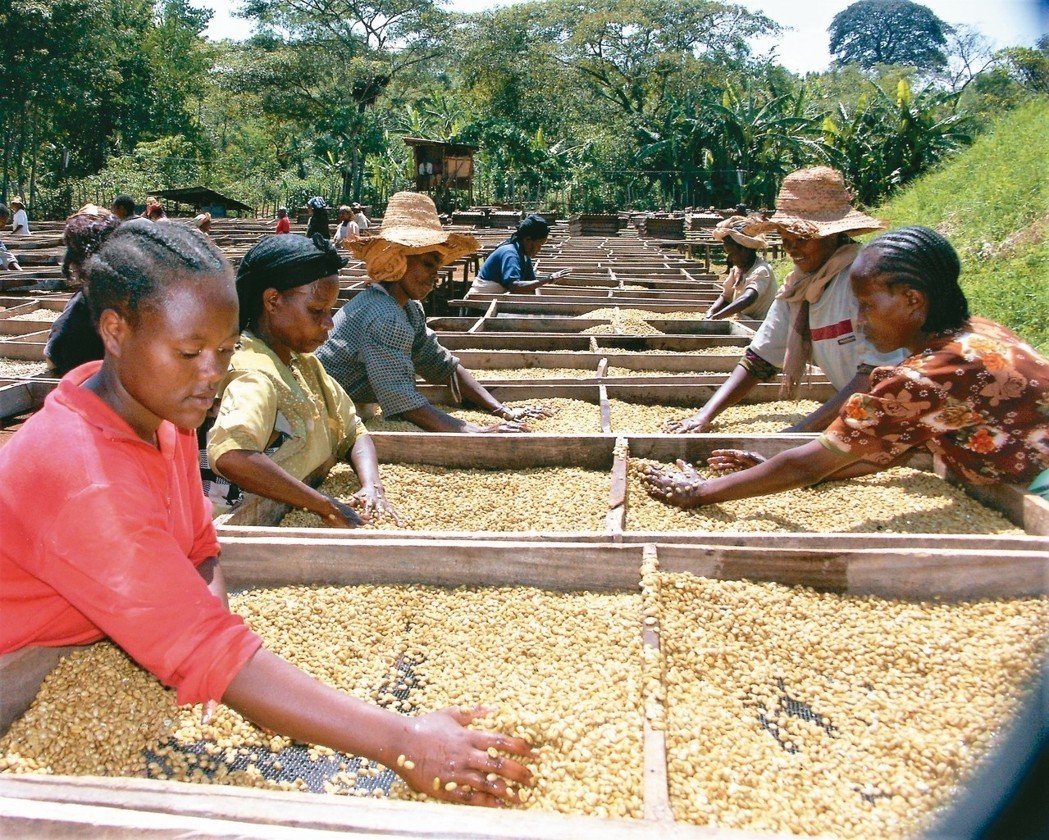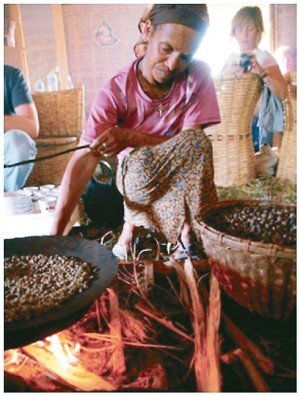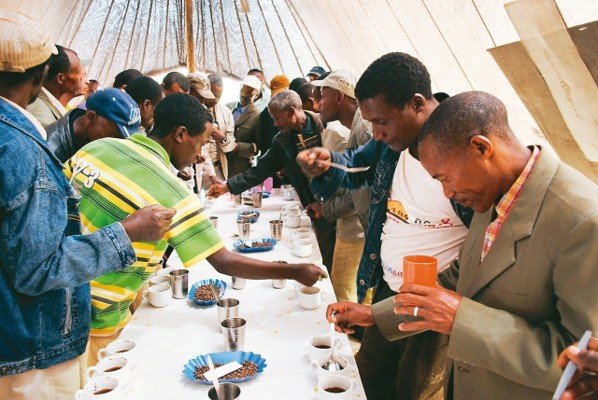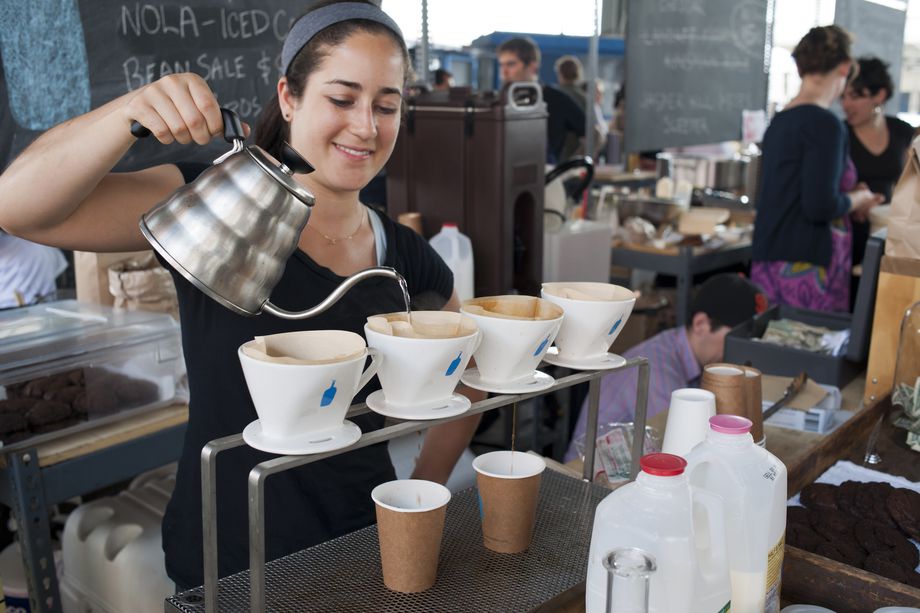Bean hunter's African curiosity: walk into Ethiopia and open the treasure house of coffee beans
Professional coffee knowledge exchange More coffee bean information Please pay attention to coffee workshop (Weixin Official Accounts cafe_style)

Hand-turned beans, sunburned. Photo/Xu Baolin (Provided by Writing Music Culture)
Those who have a general understanding of coffee history know that Ethiopia is not only the birthplace of coffee, but also the holy land in the eyes of bean hunters and the treasure house of coffee genes. Among the thousands of coffee trees born in Ethiopia, only "Typica" and "Bourbon" have opened branches and scattered leaves all over the world, making a thriving fine coffee industry.
In 1931, a local variety selected for testing and research was sent to Kenya, Uganda, Tanzania, and across the ocean to Costa Rica's Agricultural Variety Laboratory, where it was tested by Don in 1963. Don Pachi Serracin was brought to Panama to be planted, but the taste test after harvest was disappointing, and only received a Poor cup quality rating.
However, as the tree took root in Panama, some of it took root at higher altitudes, and finally showed its beauty in the 2004 Best Of Panama (B.O.P.) competition. Subsequently, this new coffee variety, known as Geisha, continued to break bidding records and has become one of the most expensive coffees in the world today.
Untouchable mysteries

After coffee is brewed, it is served first to the elders, then to the distinguished guests, and finally to the younger ones. Photo/Xu Baolin (Provided by Writing Music Culture)
Just a single coffee variety that has spread to a foreign country by chance can create legendary value. No wonder the Ethiopian government allowed experts from all over the world to sample seeds in the early years, but now it is strictly forbidden to export any coffee variety or gene sampling. Any research must obtain permission from the central government, and strict control is imposed.
There are still thousands of excellent varieties scattered throughout the country in natural forests and coffee gardens, which are invaluable genetic treasures of Arabica. Ethiopia is not only proud of its coffee homeland, but also the only uncolonized country in Africa. So far, World Coffee Research (WCR) has been unable to obtain the approval of the Ethiopian government to enter the gene bank and can only take seed research and development in the periphery of South Sudan and Congo.
In addition to an invaluable library of varieties, Ethiopian coffee has a wonderful variety of flavors, depth, width and breadth unmatched in the world. Ethiopia is a landlocked country in East Africa with a population of 100 million and a land area about three times the size of California. It has rich landscapes. If you look at Ethiopia from high altitude, you can clearly see that the Great Rift Valley (Graben) of East Africa runs through it, forming a series of high mountain valleys and lakes, including the hot desert at the eastern end and the jungle area where the summer seeds originate in the southwest. The high altitude mountains of the vertical valley are the coffee belt of the country.
Rose Summer Seed Traceability Project

Roast coffee in clay dishes and add spices to firewood. Besides etiquette, it can also repel insects and mosquitoes. Photo/Xu Baolin (Provided by Writing Music Culture)
Panama donkey farm (Finca La Mula) owner William Williem Boot once described it as "drinking the coffee of a geisha and knowing that she has stolen my heart!" The 2006 Geisha species traceability tour was led by William. There are three villages near Ethiopia's Mount Guisha, all pronounced Geisha, but there is no on-site visit to collect coffee berries, it is impossible to solve the mystery of where the real origin of the rose seed is. This trip to find the roots of the rose summer is based on historical records and scholars 'itinerary records, and it is also the first visiting team after 1970.
The nearest coffee comes from Bench Maji, which is located in the southwest of Ethiopia, close to neighboring Sudan, not far above Teppi, both of which belong to Kafa Province. To get to Banchimarji, Tiepi is usually used as a lodging and logistics point.
When the subway co-op heard we were looking for $24 a pound of rosewood coffee, they looked blank, but kindly offered to help. Because of the heavy rain, we could only reach Mizan near rosewood hill. We trekked into the mountains of Bangka, and although we found wild coffee trees, the local government official, seeing it was late, urged us to return. Later, he learned that he had heard the low roar of lions. The mountain people in this area often have direct experience with lions.
Although this trip did not reach the destination, the material conditions along the way were poor, there was no hotel to stay in and no food to eat, the mountain road was muddy, and almost everyone slipped one after another, but no one complained during the whole journey.
In 2006, the year after Geisha's journey, I received the 2007 Lingo Elementary School Project, which was established by USAID to help coffee farmers set up elementary schools so that children could have access to education, and to mobilize agricultural experts to improve the quality of coffee. After the project ended, the school was forced to close, and Gashaw Kinfe Desta, owner of Geisha Manor, decided to raise his own funds to keep the students in school; in 2009, due to emotional factors from Geisha's trip, I decided to participate in the project to purchase coffee from the manor as an alternative purchase before the summer planting in the district was confirmed. But although the estate is known as Geisha Estate, the flavor is not very similar to our experience of Geisha Estate.

Sponsored by USAID in 2010, Xu Baolin participated in the "Production Action Cup Test Camp", where many coffee farmers tested their own coffee for the first time. Photo/Xu Baolin (Provided by Writing Music Culture)
Yegashefi/Kocherhama Cooperative
Yirga-Cheffe is a must-visit production area in Ethiopia. I have visited more than a dozen village-level cooperatives and treatment yards before and after. This area has outstanding people. Even though Yirga-Cheffe itself is not eye-catching and the road signs are old and dilapidated, the fresh air, the fragrance of the forest, the clear river water and the fertile volcanic soil are all important geographical factors for breeding outstanding flavor. However, in recent years, frequent development, forest erosion, but also a lot of problems, especially the impact of traffic and soil conservation.
The early inhabitants of Yerga Shefi gathered in the swamp area. The place name means to live away from water. Legend has it that the French first discovered the outstanding coffee flavor in this area. Today, Yerga Shefi is a must-have item for every fine bean merchant. It is famous all over the world for its floral and delicate lemon citrus flavor. Located in Ethiopia's southern plateau region, this region is the first choice for bean hunting trips to the southeast. Coffee trees grow at an altitude of 1,700 to 2,200 meters. The administrative region is in the north of Sidama Province, not far from Lake Abaya.
Hama Junior Co-op is located in Yejia Shefi. It was unknown before the competition mode was introduced to Ethiopia. It won the first place in the sun group and the second place in the washing group for two consecutive eCafe competitions. It won the hearts of "Maruyama" in Japan, Estate Coffee in Denmark in Northern Europe and Osher Coffee in Taiwan. It has become a well-known Yejia District Small Co-op. What is more, Hama has early contact with international buyers and understands the importance of maintaining quality.(But whether the long-term quality does not fall, still need batch by batch cup test to identify).
My first visit to Hama was in October 2006, just before the harvest season began. I passed through the famous misty valley and wound my way up until I reached the town of Hama, which was 2,200 meters above sea level. The cooperative was located in a slightly sunken part of the valley. Since then, I have visited Hama three times. Since its first introduction in 2007, Hama has been communicating through YCFCU cooperatives since 2008. Due to its scale and financial relationship, Hama cannot directly sell overseas through DST mode. Through large upstream cooperatives is a procurement mode. The procurement process is more complicated and requires patience and time-consuming psychological preparation.
In 2009, Osher's barista Li Yating won the first World Siphon Competition in Tokyo with Hama beans, so that the Japanese coffee industry better understood the origin of Hama. The following year, NHK came to Taiwan for an exclusive interview, which made Hama more popular.

Yegashefi district wash field. Photo/Xu Baolin (Provided by Writing Music Culture)
(This article is excerpted from "Bean Seeker 2, African Curiosities of International Coffee Review: The Latest Trends in Cooperative Bean Selection, Variety Stories, and Processing")
END
Important Notice :
前街咖啡 FrontStreet Coffee has moved to new addredd:
FrontStreet Coffee Address: 315,Donghua East Road,GuangZhou
Tel:020 38364473
- Prev

Excessive caffeine intake beware of withdrawal symptoms and caffeine intake.
Professional coffee knowledge exchange more coffee bean information Please follow the coffee workshop (Wechat official account cafe_style) A woman surnamed Zhang in Nantou County, Taiwan, China, recently drank more than 2 cups of coffee a day, but recently, as long as she didn't drink it all day, she would have a severe headache, which would improve if she drank it. After seeing a doctor, it is judged that coffee withdrawal leads to withdrawal headache, and the number of headaches has been reduced after adjusting the amount of drinking. twenty-eight
- Next

Dying of hand coffee? Will hand-brewing coffee be replaced by automatic hand-brewing machines?
Professional coffee knowledge exchange more coffee bean information please follow the coffee workshop (Wechat official account cafe_style) ask: exactly how many people go to the coffee shop will specially order a cup of coffee (pour-over coffee), and interested to learn about the origin and flavor of coffee? Yes, but very few, except for coffee lovers, more people want to order.
Related
- Beginners will see the "Coffee pull flower" guide!
- What is the difference between ice blog purified milk and ordinary milk coffee?
- Why is the Philippines the largest producer of crops in Liberia?
- For coffee extraction, should the fine powder be retained?
- How does extracted espresso fill pressed powder? How much strength does it take to press the powder?
- How to make jasmine cold extract coffee? Is the jasmine + latte good?
- Will this little toy really make the coffee taste better? How does Lily Drip affect coffee extraction?
- Will the action of slapping the filter cup also affect coffee extraction?
- What's the difference between powder-to-water ratio and powder-to-liquid ratio?
- What is the Ethiopian local species? What does it have to do with Heirloom native species?

